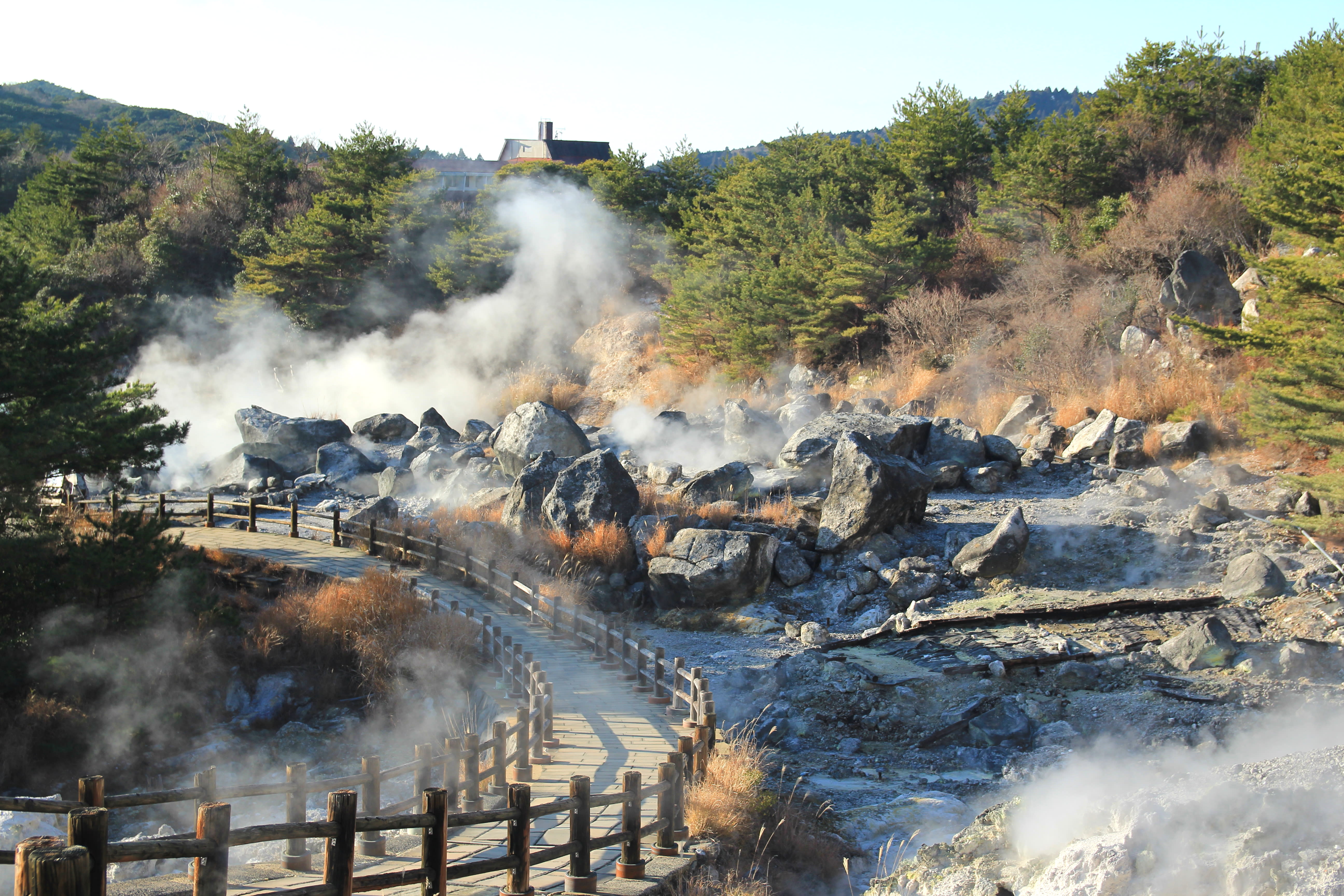Don't Miss
- Observing a newborn volcano known as Mount Heisei-Shinzan
- Watching dolphins play in the Hayasakiseto Strait
- The bubbling sulfuric vents of Unzen Jigoku
- Learning how to hunt fossils on Goshoura Island
Unzen-Amakusa National Park is full of contrasts, from smoldering volcanoes covered in delicate flowers to gothic churches in secluded fishing coves. This geothermal hotbed is surrounded by a stunning archipelago where you can watch dolphins, dive, and even learn about hunting dinosaur fossils with a hands-on experience at the Fossil Collection Site. With a fascinating history and a landscape that continues to transform, Unzen-Amakusa is packed with natural wonders and culture.
Unzen-Amakusa National Park covers parts of Nagasaki, Kumamoto and Kagoshima prefectures. It is divided into two areas: the mountainous Shimabara Peninsula, dominated by Mount Unzen, and the Amakusa area, an archipelago of around 120 islands. The park stands on multiple fault lines and has several active volcanoes that continue to shape the terrain. The rocky cliffs of the Amakusa Islands look out over seas filled with coral, dolphins, turtles and other creatures. Besides the sheer beauty of the area, Unzen-Amakusa National Park is rich in historical and cultural facets, including churches, chapels and prehistoric artifacts.
Repeated volcanic activity created the Shimabara Peninsula 400,000 years ago. Imposing Mount Unzen, an active volcano made up of several stratovolcanoes, stands at its heart. This fiery peak was responsible for Japan’s worst volcanic disaster when it erupted in 1792. Pyroclastic flows from Mount Unzen’s most recent eruptions between 1990 and 1995 formed Japan’s newest volcano, Mount Heisei-Shinzan (1,483 m).
Despite its notorious reputation, Mount Unzen is a place of astounding natural beauty. At the Nita Pass Observatory, you’ll find trailheads and a cable car. While Mount Heisei-Shinzan is off-limits because of unstable lava blocks, you can view its smoking peaks by hiking up to the summit of Mount Fugen (1,359 m). Alternatively, take the cable car to the observation deck, perched partway up the slopes. Mount Unzen is particularly beautiful in the spring when it is blanketed in pink Kyushu azaleas and Japanese flowering dogwood. In summer, look for the Narcissus flycatchers and little cuckoos that migrate to the area.
The Unzen Jigoku hot spring fields sit at Mount Unzen’s foot. Jigoku means “hell,” and the barren rocks, sulfuric plumes of steam and bubbling vents of acid certainly conjure up inferno-esque images. Walkways circling the vents allow you to view these sizzling beds of rock up close. You’ll find a variety of vegetation nearby, such as Japanese red pine and hot spring algae.
Volcanoes and hot springs go hand in hand. Slip into the healing waters of Obama Onsen, a 1300-year-old hot spring town located close to the magma reservoir of Mount Unzen. These hot springs are a rare mixture of volcanic chlorine gas, seawater and groundwater. They’ve earned the reputation for being some of the hottest springs in Japan. The town overlooks Tachibana Bay.
Indo-Pacific bottlenose dolphins frequent the seas surrounding the Shimabara Peninsula. You can take a short boat ride to the Ariake Sea and watch them frolic any time of the year.
If you’re a history buff, head to snow-white Shimabara Castle, originally built in 1624. While you are in the area, try Shimabara somen noodles, a local specialty prepared with water from Mount Unzen and sea salt from the Ariake Sea. These noodles reportedly came from China in the Middle Ages.

The Amakusa area includes three main islands—Shimoshima, Kamishima and Oyano. All three islands are connected by bridge to mainland Kumamoto. Ferries provide connections to the smaller islands.
This archipelago rose out of the ocean bed about 47 million years ago. Goshoura Island, in particular, is a treasure trove of dinosaur and marine clam fossils. You can go fossil hunting near the Goshoura Cretaceous Period Museum. If you are lucky, you might find rare marine fossils like ammonites to add to the museum collection.
There are plenty of marine activities around the islands to keep you occupied, including snorkeling, diving and wakeboarding. The warm waters are ideal for the leisurely viewing of coral and shoals of brightly hued subtropical fish. Some spots serve as spawning grounds for loggerhead turtles—a species more commonly found around the Mediterranean.
For sweeping views of Amakusa’s archipelagic seascape, head to Mount Takabuto on the island of Kamishima. The lookout point there is a great place to view the sunset.
Head further down to the island of Shimoshima to catch sight of wild migratory birds such as the hooded crane and white-necked crane. Rocky cliffs and caves jut out of the west coast of the island. Pay a visit to Jusanbutsu Park to see the massive elephant-shaped rock called Myokeniwa rising out of deep blue waters. For a taste of history, visit the Sakitsu Church, originally built in 1873 when the ban on Christianity was lifted. The gothic-style architecture is a striking contrast to the quiet fishing village it is located in.

The Unzen-Amakusa area has long served as a gateway to Japan. This is where Buddhism was introduced in Japan, and it later served as a base for trade with Spain and Portugal. When Christian missionaries started coming to the area in the Middle Ages, many converts were persecuted and martyred at the hands of feudal lords. The ultimately unsuccessful Shimabara Rebellion broke out in 1637, led by a charismatic 16-year-old named Amakusa Shiro. Several chapels and churches dot the region, drawing followers of the Christian faith. Visit the Amakusa Christian Museum or Amakusa Rosaria Museum to find out more.